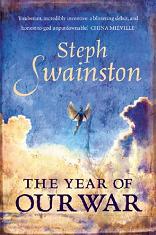
The Year of Our War
Steph Swainston
290 pages
published in 2004
I'll admit it was the China Miéville blurb on the frontcover that made me pick up this novel. For some reason the Amsterdam library is overstocked with series after series of extruded fantasy product; if it hadn't been for that quote I wouldn't have looked twice. Steph Swainston isn't somebody I had heard of before, or even seen mentioned, which goes to show how big fantasy is these days. The Year of Our War is her first novel and it promises much for the future. Since its publication Swainston has written two more books, both set in the same universe. But if it hadn't been for that Miéville blurb I never would've known about her, so score one for marketing.
If you look at just the barebones plot, The Year of Our War sounds like bog standard fantasy. The Fourlands are threatened by the Insect invasion, a mindless almost unstoppale menace which has already taken over the northern part of the world, with only the Emperor and his Circle of fifty immortals standing in their way, leading the defence against the Insects since God has abandoned the world over 2000 years ago. Jant Shira, the hero and narrator of this story is the youngest of these immortals, a crossbreed of two races, winged but flightless Awian and slender, thin half-wild Rhydanne, the result of which is that he can fly, but he's the only one in this world. Ever since becoming an immortal he has served as a messenger and it's as such that he witnesses the disaster that undoes the costly stalemate the Circle has managed to create, when the Awian King, Dunlin Rachiswater dies in an attack on the Insect lands and his weak brother mounts the throne and withdraws his troops from the wall to protect him in his capital.
Two things set this book apart from normal fantasies. First, Jant is a drug addict, addicted to a drug called Cat, which sometimes seems to sends him to an alternate world, the Shift, which only he knows the existence of and even he isn't sure that it isn't an elaborate hallucination, especially since he keeps running into dead friends there... It adds an entirely different dimension to the story, in more ways than one.
Second is the way in which Swainston tells the story. Again, though the setting seems to be the usual cod-medieval fantasyland, Swainston uses a decidedly modern, industrial language. The first page already has Jant buying a newspaper and reading a report about a previous battle that but for the details could've been published today, complete with the usual bland governmental quotes. This sort of language nicely undercuts your expectations and therefore you are forced to pay better attention to the story.
Which is good, because Swainston doesn't believe in making it too easy for the reader. There's no infodumping, the story starts immediately and you only inclued on the background situation in dribs and draps. The thrust of the main story is clear, but the context is only revealed slowly. Beyond that what I also liked was the way in which various subplots would move into view and then drop out again. It fits with Jant's personality as a narrator who, as a messenger is constantly on the move and as a drugs addict is also somewhat self centrered, or at least primarily focused on his own needs, on getting the Cat he needs. Not that this means he's an asshole, far from it; he's very likeable, but focused.
In short The Year of Our War was one of those books you have to work at to understand properly and often these puzzles are more bother than the book is worth. Not in this case however. This was a cracking read, a brilliant first effort by a writer I will keep an eye out for in future. She's already on My Amazon wishlist (hint, hint).
Read more about:
Steph Swainston,
The Year of Our War,
fantasy,
book review